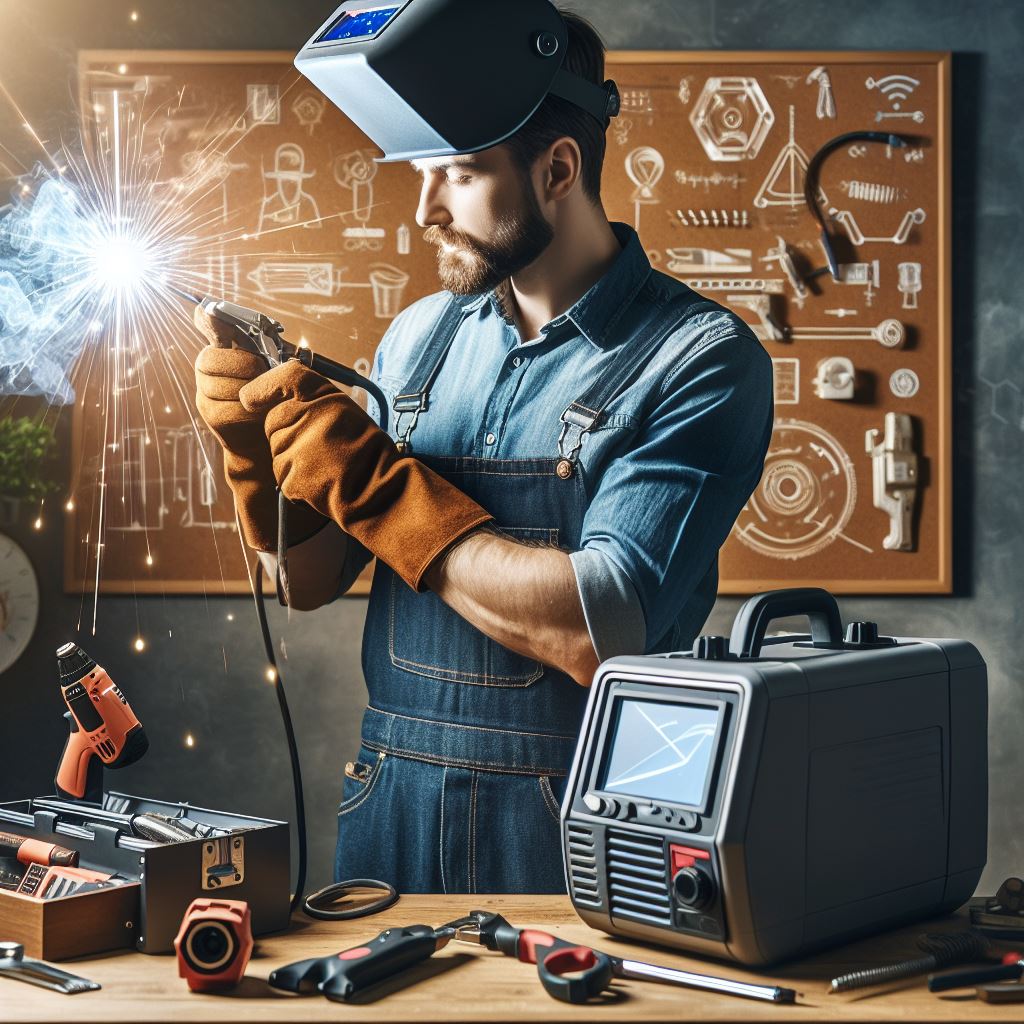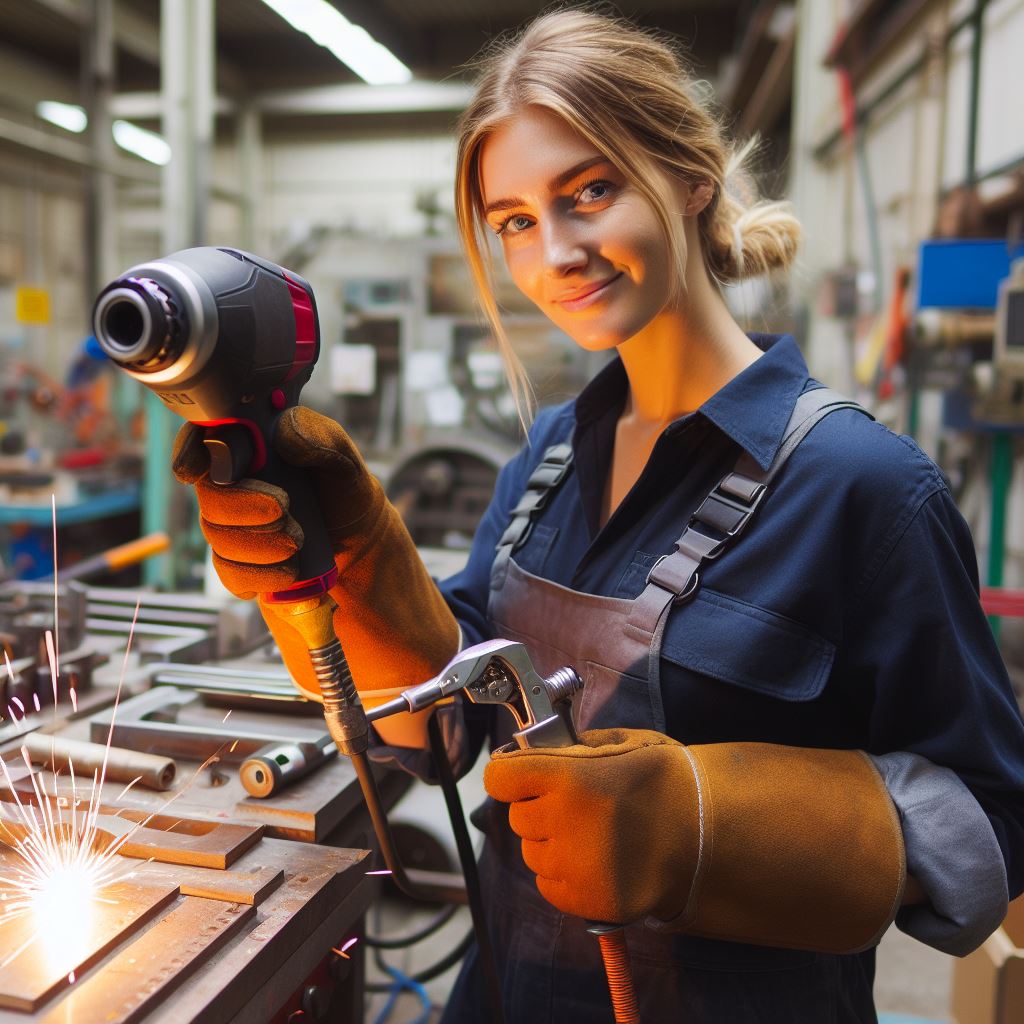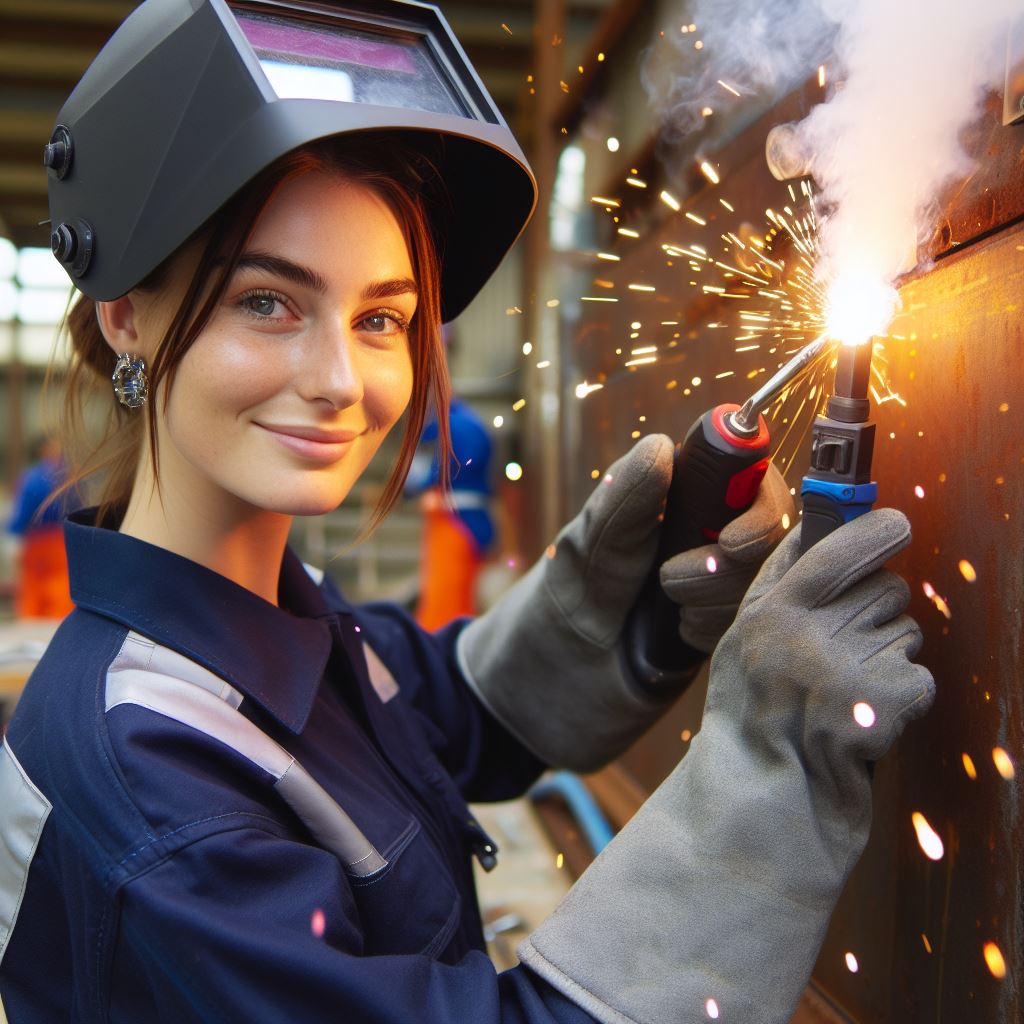Introduction
The Australian automotive industry, a vibrant and integral part of the nation’s economy, has undergone significant transformations over the years.
From the assembly lines of iconic vehicles to the adoption of advanced technologies, the sector continues to be a driving force in economic development.
Importance of welding in the automotive sector
At the heart of automotive manufacturing lies the crucial process of welding.
This intricate technique plays a pivotal role in joining diverse materials, ensuring the structural integrity and safety of vehicles on Australian roads.
Welding is not merely a technical aspect; it is the silent hero that contributes to the longevity and reliability of automobiles.
In this exploration, we aim to unravel the layers of welding’s significance within the Australian automotive industry.
From its historical roots to the modern-day applications, this post serves as a comprehensive guide, highlighting the indispensable role that welding plays in shaping the automotive landscape Down Under.
Join us on this journey as we delve into the welds that drive Australia’s automotive excellence.
Overview of Welding in the Australian Automotive Industry
Explanation of welding processes commonly used
- Gas metal arc welding (GMAW) is widely used for joining automotive components.
- Shielded metal arc welding (SMAW) is also common due to its versatility.
- Automotive body manufacturing employs resistance spot welding (RSW) to join sheets efficiently and create robust connections.
- Flux-cored arc welding (FCAW) provides higher deposition rates and deeper penetration.
Different types of welding techniques applied
- Butt welding joins metal pieces along their edges, while overlap welding bonds two or more metal sheets together.
- Overlap welding joins multiple metal sheets together by overlapping and welding them for a seamless, robust connection.
- Plug welding involves creating holes in one material and filling them with welds.
- Spot welding is commonly used to join sheets of metal quickly and efficiently.
Role of welding in vehicle manufacturing and maintenance
Welding plays a crucial role in the Australian automotive industry, both in vehicle manufacturing and maintenance.
In vehicle manufacturing, welding is utilized for
- Joining various components, such as body panels, frames, and brackets.
- Fixing structural issues and ensuring the overall integrity of the vehicle.
- Creating secure and durable joints that can withstand the demands of daily use.
When it comes to vehicle maintenance, welding is essential for
- Repairing damaged or corroded parts, ensuring the vehicle remains safe and functional.
- Restoring the structural integrity of the chassis and other critical components.
- Modifying vehicles to meet specific requirements, such as installing custom accessories.
Without welding, it would be impossible to construct and maintain vehicles in a safe and efficient manner.
Basically, welding is an integral part of the Australian automotive industry.
Various welding processes—GMAW, SMAW, RSW, and FCAW—play pivotal roles in vehicle manufacturing and maintenance.
Welders employ techniques like butt welding, overlap welding, plug welding, and spot welding to join metal components seamlessly.
Welding ensures the structural integrity, functionality, and safety of vehicles, making it a crucial aspect of the automotive industry.
Welding significantly impacts vehicle construction and maintenance, playing a crucial role in ensuring structural integrity and durability.
Read: Women in Welding: Changing Face in Australia
Qualifications and Skills Required for Automotive Welding
Educational requirements and training programs
- An aspiring automotive welder should have a high school diploma or equivalent.
- It strongly recommends pursuing vocational or technical welding training for enhanced skills and career prospects.
- Training programs provide hands-on experience and in-depth knowledge of welding techniques.
- Some vocational schools even offer specialized courses in automotive welding for better career prospects.
- Through these programs, individuals learn about safety procedures, blueprint reading, and welding principles.
Certification and licensure needed for automotive welders
- Obtaining certification from a recognized welding organization is crucial for automotive welders.
- The American Welding Society (AWS) and the Welding Technology Institute of Australia (WTIA) offer certification programs.
- These certifications validate the welder’s skills and expertise in automotive welding.
- Additionally, some states require specific licensure to perform automotive welding professionally.
- Having the necessary certifications and licenses improves job prospects and ensures compliance with industry standards.
Essential skills for successful automotive welders
- Proficiency in various welding techniques like MIG, TIG, and arc welding is fundamental for automotive welders.
- Knowledge of different types of metals, welding materials, and their appropriate applications is essential.
- Understanding and interpreting blueprints and technical drawings is crucial in the automotive welding industry.
- Attention to detail and strong hand-eye coordination are necessary for achieving precise welds.
- Problem-solving skills and the ability to troubleshoot welding issues are vital in ensuring high-quality welds.
- Good communication skills are important when working as part of a team in an automotive welding environment.
- Physical stamina and the ability to work in challenging positions or confined spaces are necessary for automotive welders.
- Adhering to safety regulations and wearing appropriate personal protective equipment (PPE) is crucial at all times.
- Continuous learning and staying up-to-date with the latest welding techniques and technologies are essential for professional growth.
- A strong work ethic, reliability, and a commitment to quality hold high value in automotive welding.
By fulfilling the educational requirements, acquiring proper certification, and honing essential skills, individuals can pursue a successful career in automotive welding.
The combination of theoretical knowledge and practical experience gained through training programs allows automotive welders to contribute to the Australian automotive industry’s growth and development.
Read: Mobile Welding Services in Australia: A Trend
Job Opportunities in Automotive Welding
Automotive manufacturing companies in Australia
- Toyota, Ford, and Holden are some of the major automotive manufacturers in Australia.
- These companies require skilled welders to assemble and join various components of their vehicles.
- Job opportunities in automotive welding are available in both large-scale manufacturing plants and smaller workshops.
- The automotive industry in Australia provides a stable and growing employment sector for welders.
Welding positions available in the automotive sector
- Automotive welders are responsible for joining metal parts and fabricating structures for vehicles.
- Some common welding positions in the automotive industry include fitter-welder, panel beater, welder fabricator, and robotic welder.
- Welders in the automotive sector work on a variety of materials including steel, aluminum, and other alloys.
- These positions require welders to operate welding equipment such as TIG, MIG, and spot welders.
Growth prospects and future trends in automotive welding jobs
- The demand for automotive welders in Australia is expected to remain steady in the coming years.
- Advancements in technology, such as automation and robotics, will impact the future of automotive welding jobs.
- The need for skilled welders who can adapt to new technologies and processes will continue to grow.
- With the shift towards electric vehicles, there will be a higher demand for welders with expertise in working with lightweight materials.
- As the industry embraces sustainability, welders with knowledge of environmentally friendly welding techniques will be in demand.
- Continuous training and upskilling will be vital for welders to stay relevant and secure job opportunities in the automotive sector.
Therefore, the automotive industry in Australia offers various job opportunities for welders. Major manufacturing companies like Toyota, Ford, and Holden require skilled welders to assemble and join vehicle components.
Welders can work in different positions such as fitter-welder, panel beater, welder fabricator, and robotic welder. Growth prospects for automotive welding jobs remain steady, with advancements in technology influencing the future trends.
Welders who can adapt to new technologies, work with lightweight materials, and employ sustainable techniques will have an advantage. Continuous training and upskilling will play a crucial role in securing job opportunities in this evolving industry.
Read: Welding Apprenticeships in Australia: A Pathway

Challenges Faced by Automotive Welders
Physical demands and occupational hazards
- Automotive welders face physically demanding tasks that require strength and endurance.
- Exposure to occupational hazards includes facing burns, eye injuries, and respiratory issues in their work environment.
- The repetitive nature of welding work can result in musculoskeletal disorders and chronic pain.
- Proper training and ergonomic practices are essential in minimizing these physical challenges.
Tight deadlines and high productivity expectations
- In the Australian automotive industry, welders often work under tight deadlines and face high productivity expectations.
- Meeting these demands can lead to increased stress levels and potential quality compromises.
- Efficiency and time management skills are crucial for automotive welders to cope with these challenges.
- Organizational support and effective communication can help alleviate the pressure and maintain quality standards.
Importance of safety precautions and protective gear
- Safety precautions and the use of proper protective gear are paramount in the automotive welding industry.
- Welders must always wear personal protective equipment to protect themselves from potential hazards.
- Failure to comply with safety measures can result in severe injuries or long-term health complications.
- Regular maintenance and inspection of machinery and equipment are necessary to ensure safe working conditions.
In review, automotive welders in the Australian industry face various challenges related to physical demands, productivity expectations, and safety precautions.
Proper training, ergonomic practices, efficient time management, organizational support, and strict safety measures mitigate these challenges.
It is essential for welders to prioritize their well-being and prioritize safety to ensure a successful and sustainable career in the automotive welding industry.
Read: Underwater Welding in Australia: Opportunities
Career Development and Advancement in Automotive Welding
Opportunities for specialization and advanced training
- Automotive welding offers various opportunities for specialized training and advanced skill development.
- Welders can specialize in different areas such as robotic welding, aluminum welding, or pipe welding.
- Advanced training programs provide welders with the knowledge and skills needed to excel in their chosen specialization.
- Continuous learning and staying updated with the latest technologies and techniques are crucial for career advancement.
- Specialized welders are in high demand in the automotive industry and can command higher salaries.
- Employers value welders with advanced training as they demonstrate a commitment to their craft and a desire for self-improvement.
- By acquiring specialized skills, welders increase their chances of securing better job opportunities and promotions.
Pathways to supervisory and managerial roles
- Automotive welders who show exceptional leadership and management skills can progress to supervisory positions.
- Supervisory roles involve overseeing a team of welders, coordinating projects, and ensuring quality control.
- Successful supervisors may further advance to managerial positions within automotive manufacturing companies.
- Managers in automotive welding are responsible for strategic planning, budgeting, and overall departmental operations.
- Strong communication, organizational, and problem-solving skills are essential for managerial roles.
- Continuing education, such as pursuing a degree in engineering or business management, can enhance career prospects for managerial positions.
- Supervisory and managerial roles offer higher salaries and greater responsibility, providing a pathway for professional growth.
Importance of continuous learning in the field of automotive welding
- Continuous learning is critical in the field of automotive welding due to rapidly evolving technologies.
- Advancements in materials, equipment, and techniques require welders to constantly update their knowledge and skills.
- Regular training programs help welders stay abreast of industry changes and maintain a competitive edge.
- Continuous learning enhances welders’ versatility, making them capable of handling diverse projects.
- Welders who actively pursue learning opportunities demonstrate their commitment to professional growth.
- Keeping up with industry advancements also ensures welders adhere to safety standards and regulations.
- Continuous learning helps maintain the quality and standard of automotive welding, contributing to overall industry growth.
Ultimately, the automotive welding industry offers numerous career opportunities for welders to advance their skills and expertise.
Specialization and advanced training open doors to higher-paying jobs, while acquiring leadership and management skills can lead to supervisory and managerial roles.
Continuous learning is crucial for staying ahead in this rapidly evolving field, ensuring welders remain competitive and contribute to the industry’s growth.
See Related Content: Essential Tools for Aussie Carpenters
Your Personalized Career Strategy
Unlock your potential with tailored career consulting. Get clear, actionable steps designed for your success. Start now!
Get StartedConclusion
Recap of key points discussed
Throughout this blog post, we have explored the topic of welding in the Australian automotive industry. We examined the importance of welding in ensuring high-quality and safe vehicles.
Uniqueness and significance of welding in the Australian automotive industry
We also highlighted the uniqueness and significance of welding in the Australian automotive industry. The industry relies heavily on skilled welders to ensure the structural integrity and longevity of vehicles.
Encouragement for aspiring automotive welders and industry professionals
In fact, we would like to encourage aspiring automotive welders and industry professionals to pursue their passion.
With the growing demand for skilled welders in the industry, there are ample opportunities for career growth and success.
By honing your welding skills and staying updated with the latest technologies and practices, you can make a significant contribution to the Australian automotive industry and be part of its continued evolution.




